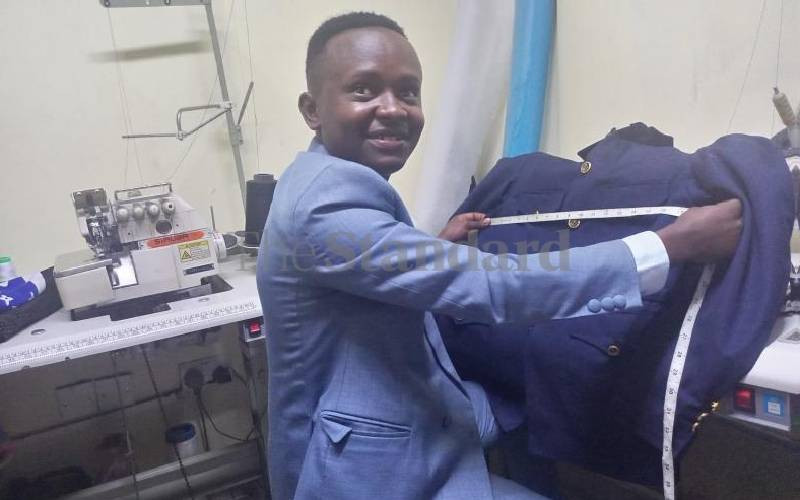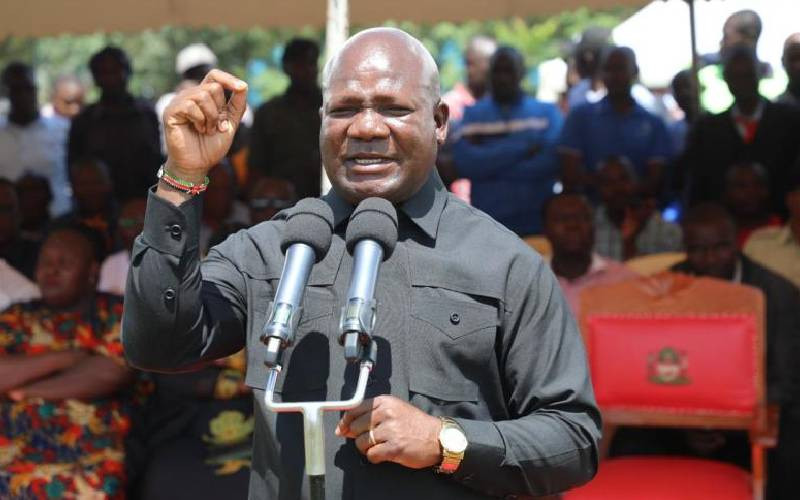In 2012, high-end fashion house Louis Vuitton featured the Maasai shuka in the menswear Spring Summer collection. There was no monetary benefit for East Africa from the Maasai-inspired outfits, but it said alot about the untapped potential of our local designs and fabrics.
It was not the first Kenyan item to receive attention on the global runway. There have been stories that non-African countries want to patent the kikoi and the kiondo. While imitation is usually the sincerest form of flattery, there are blurred lines between imitation and outright theft.
It is inconceivable that a company would imagine patenting the two items that are almost synonymous with Kenya, or Africa, but it is probably because they saw opportunities that Kenyans failed to see in their own cultural products.
After all, Africans regard products from outside the continent as superior, and only realise that local ones are also good when foreign companies snap them.
When it comes to fashion, Kenya does not have much of a dressing culture, and for Kenyans, “good enough” seems to be the unspoken mantra. That is in contrast to a country like the Democratic Republic of Congo, whose men are easily recognisable in fancy outfits, multiple gold chains on their necks and dark glasses on their heads.
A Congolese man who looks dapper is probably a sapeur, a member of Les Sapeurs, which is a large “religious” movement whose object of worship is fashion. Even those who are not sapeurs traditionally dress in bold prints and vibrant colours that Kenyans would refer to as “shouting” — a uniquely Kenyan way of describing colours they consider overly bright.
Things are changing though, and there are Kenyans who are obeying dress codes and dressing for the occasions. The change can be credited to wedding shows and fashion programmes on television. Even fashion bloggers are gaining a following.
According to the Kenya Association of Manufacturers, the local fashion design and apparel retail market is estimated at more than Sh30 billion a year.
Even then, we still have a long way to go. We do not have fashion that is uniquely Kenyan considering that Tanzania also lays claim to the khangas and Maasai-inspired outfits.
Whenever African Wear is the required dress code for an event — which is an anomaly in itself as being Africans, one would imagine African wear would be our default dress code — many people drape themselves in West African attire, with khangas and Maasai-inspired being an exception.
While in Kenya a dress down, or a casual Friday means T-shirts, in Ghana, such a day is reserved for kente dress outfits, thanks to campaigns by the government for people to wear locally-designed attire. Ghana’s TV presenters also don African wear and mention their designers on air.
So why do other nations seem to have it together in terms of attire more than Kenyans do?
“It is not our fault,” says John Kaveke, one of Kenya’s top and globally acclaimed designers. “We spent a longer time being colonised and becoming westernised, so our forefathers did not grow with that kind of culture, unlike our compatriots in West Africa, who have been wearing that for ages.”
Attempts at having a Kenyan national dress were made in 2004 through an ambitious 50-million-shilling initiative sponsored by Unilever in partnership with the government.
Kaveke, the first Kenyan designer to showcase his collection at the London fashion week in 2011, was in the team of designers tasked with creating the national dress.
Stay informed. Subscribe to our newsletter
“Extensive research was conducted on the different elements of our cultural attires from different communities.
“One of the common features was the wrap, but it was very hard to pick an element from each tribe as that would have been a chaotic outfit.
“It was narrowed down to a few common cultural features and it also had modern style elements. It was about finding things that people could relate to now,” Kaveke says.
Twelve years later, most Kenyans would more easily recognise the Nigeria’s agbada and Ghana’s kente, than Kenya’s national attire.
“I think it did not take off because it was privately funded,” Kaveke says of the national dress initiative. “The government was involved, but there was no initiative to pursue and educate people on the elements that qualified it as a national dress.”
However, all is not lost, according to Eddie Kirindo. “Our culture is such that we have inherited attitudes from older generations that maintain that foreign things are better than what we have here. Changing that mentality is very difficult, but it is upto us to align our product with the way Kenyans think now.”
Eddie, who is a fashion stylist, says that the situation has changed and it is now trendy to wear Kenyan-made outfits “But there is a lot of room for improvement and designers need to understand the common denominator in the way Kenyans dress.”
He feels that the tailor has become more popular than the designer. “People get designs from fashion magazines and instruct the local fundis who invariably come up with similar outfits.”
According to designer Monica Kanari of Occasions and Days Limited, that is not a problem “Fashion has to be imitated because that is the way it moves forward. That is why we have fashion shows and runways and when designs are copied, that is a compliment to the designer.”
She says that the only problem would be if the design is copy-righted, though that is not how it works with fashion. “Unless a designer is just copy-pasting other designs and presenting them as his/ her own, there is no problem.”
So, are Kenyan designers making any money from their creative works or it is just a labour of love?
“You cannot expect me to spend sh10,000 on an outfit just because it is [made by a] Kenyan, you have to make me like it first,” Eddie points out. “Kenyans have very personalised styles, and they wear clothes because they look good and not just because they are Kenyan.”
Kaveke says that Kenyan designers need to be appreciated because they “have evolved and can now stand out regionally and internationally even though the industry is young.”
He adds that they have managed to make contemporary versions of what exists. “Designers have upped the game and create pieces that can relate to modern times.”
Kirindo says local trends would evolve if it the fashion industry was developed. “Fashion trends are usually picked up from designers by the elite. The middle classes adopt and buy in to the idea, the public picks it up and it becomes a trend. However, the industry is young and the system is not yet well developed and defined in such a way that retailers would produce in bulk and cater to everyone in the chain.”
For Akinyi Odongo, a fashion designer and CEO of MEFA Creations, the players in the fashion industry have to treat their work as businesses and speak about it for it to be recognised as such.
“During the pre-Global Entrepreneurship Summit launch, I told the President and the Ministry of Industrialisation about the issues that they needed to look into. I made it very clear that fashion is an industry that should not be ignored because it employs many people.”
As it is now, she says “there isn’t much that either we or the government has done to make it grow into a serious industry. I am trying to find out what the government is doing on this and as I learn I share whenever I get the platform.”
Akinyi has a certification from the Kenya Bureau of Standards, a move she says will push her brand. “Even as a fashion designer, people want to know if you are recognised in your country. It is a cost to business but whether you choose to pay for it annually depends on how you view your business and how you want to grow.
“It’s a decision you make and I take my business very seriously. It is business, not showbiz. This is what I eat, drink, drive and I live.”
When it comes to turning around the industry, she is not alone. There have been murmurs among them that fashion industry players need to present a united front if it is to move forward in a meaningful way. Kaveke had taken a sabbatical “to research on how the industry works; my position as a brand, how to influence other people, how to develop products that are high standard and on maintaining integrity.”
“When you step aside to look at the industry critically, you realise how much we are either missing the point or how much there is to do. Our editors, designers, stylists, photographers, bloggers – we all have to speak in one language.”
Monica agrees.
“We need to realise that we work best together when we complement each other. We have a lot of things working for us so really, we need to work together and share information on how to take advantage of the opportunities we have. Whatever challenges we have can only make us better.”
The players in the industry are also starting to speak in one voice and the first Kenyan Fashion Stakeholders forum was held in July. It was organised by Hivos, Association of Fashion Designers in Kenya and Equity Bank and the topic of discussion was formulating ways of strengthening the industry.
Investors have also started paying attention, and Equity Bank provided a sh100 million seed fund for 40 young and upcoming designers who were finalists in the Bank’s Design Your Destiny competition in March this year.
We are forming an organisation that will help bring changes in the industry,” says Eddie. “Currently, there are many loopholes that people take advantage of but those will be sealed soon.”
“For example, international fashion brands come to Kenya and models on their advertising billboards are foreigners. When we start implementing the changes, they shall be required to work with local models.
“There are fashion events all over the place, but there will be a very strict calendar, which anyone who organises an event will follow and they must be clear on what the event is about. Things like payment of models will be based on standards set up by the organisation.”
It looks like the industry is finally stitching itself together, weaving itself into the fabric of the economy and becoming part of the rich tapestry that is Kenyan culture.
 The Standard Group Plc is a
multi-media organization with investments in media platforms spanning newspaper
print operations, television, radio broadcasting, digital and online services. The
Standard Group is recognized as a leading multi-media house in Kenya with a key
influence in matters of national and international interest.
The Standard Group Plc is a
multi-media organization with investments in media platforms spanning newspaper
print operations, television, radio broadcasting, digital and online services. The
Standard Group is recognized as a leading multi-media house in Kenya with a key
influence in matters of national and international interest.
 The Standard Group Plc is a
multi-media organization with investments in media platforms spanning newspaper
print operations, television, radio broadcasting, digital and online services. The
Standard Group is recognized as a leading multi-media house in Kenya with a key
influence in matters of national and international interest.
The Standard Group Plc is a
multi-media organization with investments in media platforms spanning newspaper
print operations, television, radio broadcasting, digital and online services. The
Standard Group is recognized as a leading multi-media house in Kenya with a key
influence in matters of national and international interest.







